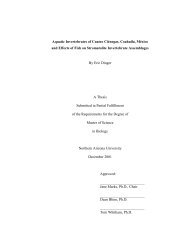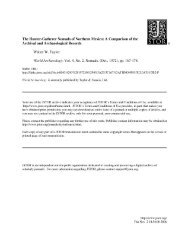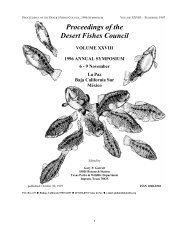Proceedings of the Desert Fishes Council 2000
Proceedings of the Desert Fishes Council 2000
Proceedings of the Desert Fishes Council 2000
Create successful ePaper yourself
Turn your PDF publications into a flip-book with our unique Google optimized e-Paper software.
PROCEEDINGS OF THE DESERT FISHES COUNCIL - VOLUME XXX1I (<strong>2000</strong> SYMPOSIUM) – PUBLISHED NOVEMBER 13, 2001<br />
Apache-Sitgreaves, BR-Phoenix: BR is conducting engineering studies for installation <strong>of</strong> fish barriers on Blue<br />
River.<br />
Razorback sucker, Xyrauchen texanus. AZGFD, Arizona State University (ASU), Bureau <strong>of</strong> Land<br />
Management (BLM), AZFRO-Parker: The annual razorback sucker census at Lake Mohave sampled 593 fish.<br />
AZFRO-Parker: The first census for razorback sucker at Lake Havasu collected 38 fish and one bonytail, Gila<br />
elegans. All were repratriates except for one razorback sucker. AZGFD: Grow-out <strong>of</strong> razorback suckers<br />
continued at <strong>the</strong> AZGFD Bubbling Ponds Hatchery. Razorback suckers averaging 10 inches TL from Bubbling<br />
Ponds were stocked into Lake Mohave, Lake Havasu, Colorado River at Parker Strip, and Verde River near<br />
Childs. In addition, 90 large (avg. 450mm) razorback suckers and 14 bonytail were reared at Davis Cove, a<br />
grow-out pond in Lake Mohave. Sampling <strong>of</strong> <strong>the</strong> Verde River to monitor reintroduced Colorado pikeminnow,<br />
Ptychocheilus lucius, and razorback sucker was conducted. Between Beasley Flat and Childs, seven razorback<br />
suckers were caught. All were in generally good health, with little parasite loading. No Colorado pikeminnow<br />
were caught. Natives fishes made up 26% <strong>of</strong> <strong>the</strong> electr<strong>of</strong>ishing catch. During investigations <strong>of</strong> <strong>the</strong> fisheries in<br />
Fossil Creek drainage, two razorback suckers were captured in Stehr Lake, a small regulating reservoir <strong>of</strong> <strong>the</strong><br />
project. They were probably survivors <strong>of</strong> fish stocked <strong>the</strong>re in <strong>the</strong> 1980s.<br />
<strong>Desert</strong> pupfish, Cyprinodon macularius. AZFRO-Parker: Refugia for desert pupfish on Cibola and Imperial<br />
national refuges were established and stocked. Fish were from <strong>the</strong> stock established from El Doctor, Sonora,<br />
Mexico. AZESO: A highway flood-water retention basin in Tempe is currently proposed for stocking under a<br />
Safe Harbor agreement with Gila topminnow and desert pupfish. The Safe Harbor agreement provides for<br />
actions that promote conservation and recovery <strong>of</strong> <strong>the</strong> species by providing refugia sites, while allowing<br />
landowners flexibility to remove species and habitat to baseline conditions if <strong>the</strong>y desire. The agreement has<br />
stipulations for monitoring <strong>of</strong> populations and habitats and function <strong>of</strong> <strong>the</strong> agreement and provides for funding<br />
both <strong>the</strong> mitigation and monitoring provisions. An additional benefit from <strong>the</strong> action will be control <strong>of</strong><br />
mosquitoes, Hummus pestis [sic]. The permit for take <strong>of</strong> individuals under this agreement should be signed by<br />
September 30. O<strong>the</strong>r sites owned by <strong>the</strong> Arizona Department <strong>of</strong> Transportation may be used as additional<br />
refugia sites for ei<strong>the</strong>r species. AZGFD: Three reintroduced populations <strong>of</strong> desert pupfish were monitored.<br />
Finley Tank supported pupfish <strong>of</strong> questionable heritage, and desert pupfish were absent from AD Wash and<br />
Hidden Water Spring.<br />
Quitobaquito pupfish, Cyprinodon eremus. AZFRO-Parker: Began work with <strong>the</strong> Pinacate and Greater Altar<br />
<strong>Desert</strong> Biosphere Reserve to reestablish a native riparian zone along <strong>the</strong> Sonoyta River to benefit Quitobaquito<br />
pupfish. National Park Service-Organ Pipe Cactus National Monument: Has been developing sampling<br />
methodologies with ASU to assist in management and monitoring <strong>of</strong> <strong>the</strong> status <strong>of</strong> <strong>the</strong> population, working with<br />
NFS-Tonto to provide methods for early detection <strong>of</strong> nonnative fishes, and proposing to build supplemental<br />
holding facility at Park headquarters that would also serve for public education.<br />
Gila topminnow [Sonoran topminnow], Poeciliopsis occidentalis. AZFRO-San Carlos: In spring <strong>2000</strong>,<br />
began work on <strong>the</strong> renovation <strong>of</strong> <strong>the</strong> third and final spring in <strong>the</strong> Bylas Springs complex, S1. Following barrier<br />
modifications and removal <strong>of</strong> introduced riparian vegetation, <strong>the</strong> spring was successfully renovated with <strong>the</strong><br />
cooperation <strong>of</strong> <strong>the</strong> San Carlos Apache Tribe, AZGFD, Bureau <strong>of</strong> Indian Affairs, Environmental Protection<br />
Agency, and AZESO. Gila topminnow from <strong>the</strong> original S1 stock are scheduled to be released into S1 in <strong>the</strong> fall<br />
<strong>of</strong> <strong>2000</strong>. Springs S2 and S3 were successfully renovated and restocked in 1996 and 1998, respectively. NFS-<br />
Coronado: Last year's consultation with USFWS on grazing allotments resulted in mangement changes on<br />
allotments in <strong>the</strong> Redrock Canyon drainage, where Gila topminnow are present. One existing exclosure was<br />
extended, and ano<strong>the</strong>r was built to enhance riparian and aquatic conditions for <strong>the</strong> species. Annual monitoring<br />
<strong>of</strong> Gila topminnow and western mosquit<strong>of</strong>ish in Redrock Canyon shows a generally downward trend in relative<br />
abundance <strong>of</strong> topminnow over <strong>the</strong> past 11 years, with topminnow last year (October 1999) comprising 47% <strong>of</strong><br />
<strong>the</strong> total catch. BLM: In September, Gila topminnow were stocked into Lousy Canyon in <strong>the</strong> Agua Fria<br />
drainage. This stream is already <strong>the</strong> site <strong>of</strong> a restoration stocking <strong>of</strong> Gila chub. This is <strong>the</strong> first new Gila<br />
topminnow population started in <strong>the</strong> wild since 1993. AZGFD: Acute tolerances <strong>of</strong> Gila topminnow and western<br />
mosquit<strong>of</strong>ish to ammonia and high water temperatures, as well as <strong>the</strong>ir use <strong>of</strong> simulated emergent vegetation,<br />
were determined in order to evaluate each species' potential to effectively control mosquito larvae in constructed<br />
wetland habitats. Fifteen localities were monitored for presence <strong>of</strong> natural Gila topminnow populations. Only<br />
ten <strong>of</strong> <strong>the</strong> locations continue to support topminnow: Bylas Spring, Middle (or “MZ”) Spring, Salt Creek,<br />
Redrock Canyon below Cott Tank, Sonoita Creek below Patagonia Lake Dam, Monkey Spring, Fresno Canyon,<br />
19



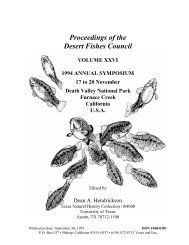
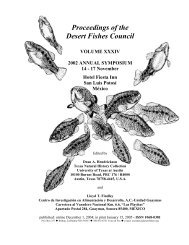
![Part 2 [419KK] - Desert Fishes Council](https://img.yumpu.com/14712282/1/190x245/part-2-419kk-desert-fishes-council.jpg?quality=85)

